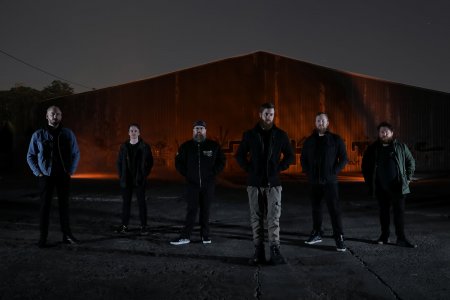Breathtaking live shows, scientific historical research and strong connection to nature. These are just a few descriptions of Norwegian formation Wardruna, which has a massive and continuously rising fan base in Czech Republic and globally. It is led by charismatic frontman Einar Selvik, with whom I had an opportunity to talk again after we did a video interview before their sold out show in Prague’s legendary hall Lucerna in 2019. I fully recommend seeing them live, but due to current pandemic situation it won’t be possible for a while. As a summer festival season of 2021, including Colours of Ostrava festival, was still quite unsure, Wardruna prepared for late March 2021 a stream show called First Flight of the White Raven. In our interview we spoke next to the preparation also about a creation of band’s latest album Kvitravn also similarities within the cultures around the world.
Cover photo credit: Arne Beck
Czech version of this interview for Muzikus magazine here
We spoke together last time when you came to Prague for a sold show in Lucerna venue. We did a video interview at the balcony shortly before the show. It was a great discussion. Thank you for finding time again.
Pleasure is mine, sir.
First of all, I have to ask you, what your feelings were after the show, as I was truly impressed with the dedication from the fans. You have incredible fan base here in Czech Republic.
Gratitude, I would say. Yeah, we do have the best audience in the world. They connect very personally to the music, it seems. And we are feeling that love. It’s a special feeling and connecting to so many people in that way. It does leave you with feeling grateful. Thankful for it.
We are now dealing with the limitations around the world and cultural events are quite limited and will be limited for a while. Therefore we are doing this interview to promote your upcoming stream First Flight of the White Raven at the end of March. Give us please an idea about the setting where you will be playing. Or is it still a surprise?
Yeah, but I can generally talk about my thoughts about it, as it’s a different format. Doing an online format or a virtual event such as this, you, it wouldn’t make sense to sort of just step on top of stage and do your normal thing, as it would be a performative format. Doing it as a virtual concert, I think the approach should be different. And you’re, of course, also free to break out from that normal stage setup. Plus you can be creative in other ways and those are the things we want to explore, to find. We have to find other ways to create an atmosphere that connects us all to the music in a way. That’s the primary goal. To perform within a context that amplifies the expression.
It will be definitely strange to miss that direct feedback from the audience. Personally, due to pandemic, I started teaching English and Serbian again. I was just recently asked to make a presentation on Serbian language, by my friends from a theater NOD in the central Prague, who had to adapt and started doing lectures on everything including fake news, history or languages. So I did the lesson and had ten technicians just looking at me, following every bloody thing that I did, but only a janitor not holding a camera could laugh.
Haha, exactly. When you can’t feed off the audience, you have to feed off your own environment. And of course, I will be standing in the middle of sound and be the face of a song. So it just means that you have to connect to that part more. But of course, that’s a different thing than doing a zoom lecture. I’ve done quite a bit of these online events, meet and greets or Q&A. And yeah, it’s strange not to connect, as I really do like to connect. To look people in their eyes and feed off that energy. It’s an important part of communication. And that is lost in the current situation.
Sacred source
Talking about current situation, how are you dealing with it these days? Do you spend more time in the nature then before?
Yeah, I guess that’s something I always used. I rely on this tool, as nature is medicine. It kind of grounds you and allows you to catch up with your own thoughts. I’m lucky in the sense that I live in the countryside. So there is an abundance of nature. That’s not only in this situation, but in general it’s necessary room of healing and reflection.
In my case, I love to keep the end of my route very raw and get lost in some way. It might be more challenging journey, but it really helps me to release everything and it creates a setting where completely unique thoughts come up. So I understood, in your case, that you coming up with the first main impulses and ideas for songs, during your walks, right?
Yeah, my walking has intuitively always been my sort of main muse in my work. And as you say, it’s a great tool. And of course, if you look back in history, this is a tool that has been actively used by philosophers, artists and writers in so many different cultures for thousands of years. It frees the mind, as you say, and you hear your thoughts in a different way. And yeah, it can be a great tool for reflecting and just freeing the mind. Because when you’re in movement, and when you’re surrounded with nature – the thing we’re a part of, but we often forget we’re part of – it does something to you. And of course in these days, it’s especially impactful because we are so numbed in our brains because of all the computers and phones and everything that it draws our attention away from our own thoughts and feelings. It creates very unhealthy and unbalanced relationship there. Of course walking doesn’t have to always take place in nature. Sometimes actually the absence of nature can bring you closer to you as well, as we would start to understand we are missing the nature. It can be a very powerful creative tool. I also apply traditions and a thought pattern that have always been part of many of these older nature based traditions or animistic traditions. This idea that everything has a sound, song or a frequency that you can potentially tap into and learn. So I am more actively listening to things and both how you feel and what comes up when melodies or words are actively going out. Asking for things in a way so. So that’s also an approach I do.

I’m not the same person as I was yesterday
Traditions for a modern listener
Did you experience some interesting discovery within a research of traditional instruments, let say during an interesting discussion with a much older player?
Our new album is a result of everything, all the experience, all the talks that I’ve done so far in my life. I’m not the same person as I was yesterday, in a way. And so that organic natural development is, of course, a huge part of it and has been for, since the very beginning. Talking to instrument builders and players is very important, as they carry very old traditions. Learning from these people and constantly recalibrating my own perspective is a very important part of the process. I tried to stay very open and not be very fixed in some predetermined idea of how it shouldn’t be. And that’s how it is. Because, frankly, we don’t know. There are so many things we don’t know. And we can only assume. We can only guess. And I think that’s a very healthy attitude, not only to have it in the sense of all this stuff that I’m working with, but just being a human as well, you know. Yeah, if I had stuck to what I thought was the truth or my experience of the truth when I was fifteen years old that wouldn’t make much sense. So I tried to stay very open minded, whether it is as a musician or as a human being.
Throughout your career, you did many things yourself, including a production. But it’s nice to see that Tony Lindgren returned to the mastering and you kept working with Iver Sandøy. Traditional instruments received a very modern production, but at the same time you are not afraid to outsource.
It’s very important to have good people that understand what you are, what you want and so on. That’s a really important thing. And throughout the years I’ve sort of found people. And, you know, our first album released in 2009 that was the first album I ever recorded and produced myself. So this whole process has been a very “learn as you go” kind of thing. I am also getting better in not being afraid to ask for help, when I need it. I draw an inspiration from instrumentation, tools and techniques that go back to the Stone Age, Bronze Age, Viking Age, medieval times or modern times. The intention is to always create something new, not replicate something old, you know. I’m creating music for the hearer now and of the future. So applying modern techniques and ways of thinking, in terms of production, that’s a big part of growing as well.

We are reaching the final minutes of our interview. Therefore I wanted to check for the last thing, ig your listening spectrum also reaches jazz? Especially with the last album I felt a couple of elements related to two British alternative jazz formations: Sons of Kemet a Shabaka and the Ancestors. They are both working with the darkest aspects of African continent. It’s impressive what moods this sort of music can create in the mind of a listener. I believe you came over the year across cultures which are working with the darkest aspects of their traditions.
Yeah and not only the darkest. But it is very interesting and people should be aware of, not only in musicology, regarding mythology and other parts of traditional culture. When you go far enough back in time, you see how strikingly similar they are, in terms of rhythmical patterns, tonalities and even instrumentation. Going far enough back in time you see how connected they are and how similar they are from all the corners of the earth. Looking into other indigenous cultures, I’m searching the ruins of our own fragmented history. I think a lot of what you do see in the rhythms and poetic structures of all of this traditional music, it has a lot of similarities to jazz and other where you have these crooked beats. I think a lot of people have this predetermined notion that people back in earlier times just smashed rocks together. But the fact is that we are the ones doing that compared to the older ones. It’s interesting that it has certain rhythms they aren’t a circle they are more like an egg. It is fascinating to see how interconnected and going far enough back in time how strikingly similar our cultures are within the music, but also in regards to other things.
Thank you very much for your time. Enjoy the rest of the interviews and hopefully see you soon in Czech Republic.
Thank you. Take care.






